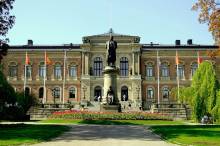Future plans for the University’s physical environment
 Posted date: 09 Jan 2021
Posted date: 09 Jan 2021
Uppsala University’s Vice-Chancellor has approved the plan that will provide the guiding principles for the University’s future spatial structure and physical expression for the coming decades: Development Plan 2050. The plan has been developed through a broad dialogue with both internal and external stakeholders intended to spur development of a cohesive knowledge environment and increased collaboration.
Well-functioning work and teaching environments support education and research. To achieve its ambitious goals, the University’s physical development requires a long-term plan. The purpose of the Development Plan 2050 project has been to formulate guiding principles for the University’s future spatial structure and physical expression. The plan is an important framework for the coming decades and will provide the guiding principles for the premises provision plans that are formulated every three years.
Currently, Uppsala University has at its disposal close to 400,000 square metres in Uppsala and Visby. Development Plan 2050 provides guiding principles and the foundation for Uppsala University’s development and enables external collaborations in both cities and their surroundings. The University’s activities and facilities impact its surroundings, while its surroundings impact the University.
Development Plan 2050 expresses a vision, supported by four specific goals, that provides the foundation for Uppsala University’s future planning. These goals include such aspects as moving toward a cohesive knowledge environment and increased collaboration, sustainability, integration with the city, and increased presence and visibility. Several overarching strategies are described for achieving these goals.
Development Plan 2050 should be viewed as an overt declaration of what the University wants in its future physical development and be seen as an expression of the University’s ambitions and hopes for the built environment.
Posted By

GSP Admin




